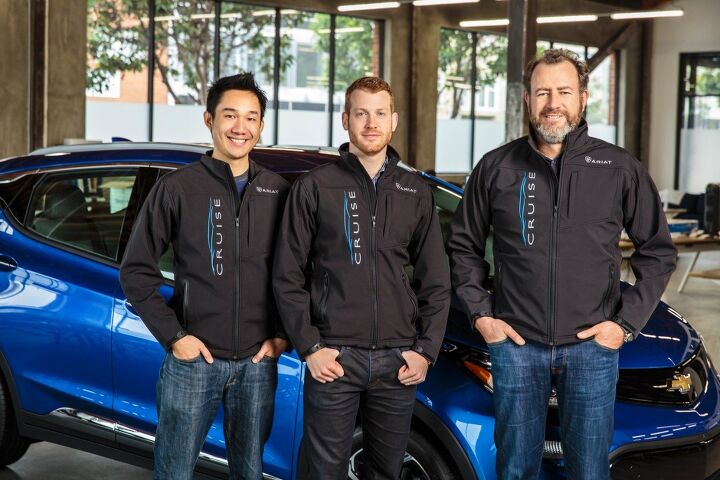GM's Self-driving Team Fires Back at Tesla With New Autonomous Bolt Video

General Motors’ self-driving startup, Cruise Automation, has trickled out dash cam videos of an autonomous Chevrolet Bolt milling around San Francisco since February. The video quality was poor and it wasn’t anything we hadn’t already seen from a self-driving car. Tesla went so far as to call tech startups like Cruise Automation and Otto “small teams of programmers with little more than demoware” and scolded Ford, GM, and Uber for investing billions of dollars into “unproven” projects.
However, Cruise’s most recent video seems to show that it has made some legitimate progress in the last three months. Set at night, the clip shows the self-driving Bolt navigating a dense urban environment while avoiding collisions with cyclists, pedestrians, and even a raccoon.
We have to take General Motors’ word for there being zero human intervention, since we never get a clear view of the steering wheel, but the company has assured us that is the case. We also noticed the Bolt never makes a single right turn on red, even when it seemed safe to do so, and reached out to GM to ask why.
The automaker explained that, while the test vehicle is capable of a red right-hander, the engineers had disabled the feature. When we asked why, our corporate contact said they couldn’t elaborate on the specifics of the technology but assured us that General Motors places safety as the overriding priority in the development process, meaning the company probably doesn’t want to take on the added risk until the system is further along. Understandable, given some of the bad publicity Uber’s test cars have received of late.
Hoping to surpass rival autonomous developments, GM is investing like mad in Cruise Automation. Last week, IEEE Spectrum broke the news General Motors was planning to expand its test fleet beyond 300 vehicles — which would make it one of the largest — and add 1,100 positions within the Californian startup.
At the moment, there are only about 50 self-driving Chevy Bolts undergoing development in Michigan, Arizona, California. GM is using its deep pockets to change that, and has placed itself nearer to the front of the pack in the race toward level 5 vehicular autonomy.
[Image: General Motors]

A staunch consumer advocate tracking industry trends and regulation. Before joining TTAC, Matt spent a decade working for marketing and research firms based in NYC. Clients included several of the world’s largest automakers, global tire brands, and aftermarket part suppliers. Dissatisfied with the corporate world and resentful of having to wear suits everyday, he pivoted to writing about cars. Since then, that man has become an ardent supporter of the right-to-repair movement, been interviewed on the auto industry by national radio broadcasts, driven more rental cars than anyone ever should, participated in amateur rallying events, and received the requisite minimum training as sanctioned by the SCCA. Handy with a wrench, Matt grew up surrounded by Detroit auto workers and managed to get a pizza delivery job before he was legally eligible. He later found himself driving box trucks through Manhattan, guaranteeing future sympathy for actual truckers. He continues to conduct research pertaining to the automotive sector as an independent contractor and has since moved back to his native Michigan, closer to where the cars are born. A contrarian, Matt claims to prefer understeer — stating that front and all-wheel drive vehicles cater best to his driving style.
More by Matt Posky
Latest Car Reviews
Read moreLatest Product Reviews
Read moreRecent Comments
- ToolGuy TG likes price reductions.
- ToolGuy I could go for a Mustang with a Subaru powertrain. (Maybe some additional ground clearance.)
- ToolGuy Does Tim Healey care about TTAC? 😉
- ToolGuy I am slashing my food budget by 1%.
- ToolGuy TG grows skeptical about his government protecting him from bad decisions.


































Comments
Join the conversation
Nearly every state and municipal government uses ArcGIS to manage road network data on one level or another. It would seem like one answer to this problem is to publish the metadata for speed limits and other signs via web services from their ArcGIS Online accounts. The general public, including automakers and other companies could then receive updates in real time when signs are changed. A little team play between the public and private sectors would go a long way. That might be more straight forward than depending upon sophisticated camera's to read signs in various lighting and weather conditions. Right turn on red should then be implicitly prohibited by automated driving software unless the state/municipal governments road network data explicitly offers the data with a flag that indicates that it is allowed. Then of course they could add a social feedback feature that could be fed back to state/municipal governments to indicate that they need to update their data for given intersections.
"Tesla went so far as to call tech startups like Cruise Automation and Otto “small teams of programmers with little more than demoware” and scolded Ford, GM, and Uber for investing billions of dollars into “unproven” projects." I doubt Ford or GM gives rats a$$ what Tesla thinks. When it comes to engineering prowess in how to design, engineer and manufacture a decent car they are light years ahead of Tesla. They know it, Tesla knows it.